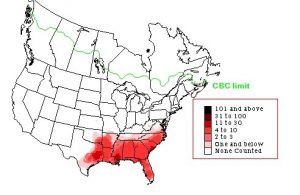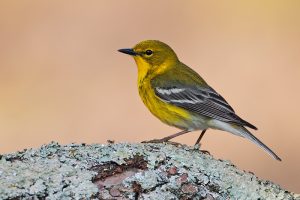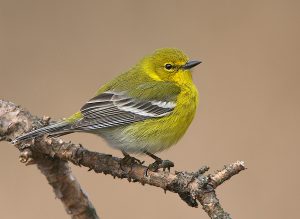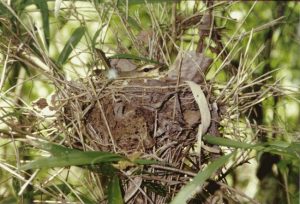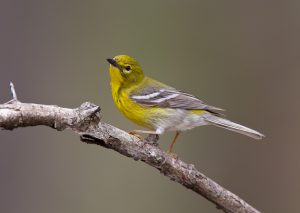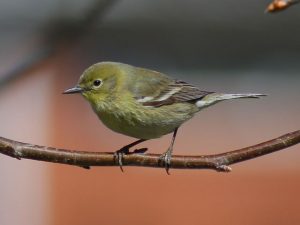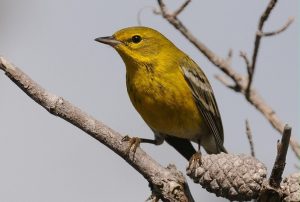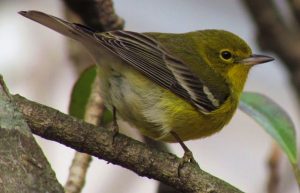Pine Warbler
An aptly named bird, the pine warbler is a member of the New World warbler family. With its numbers in a constant upswing, one would expect to spot one with relative ease; sadly though, the bird spends most of its time in pine branches at great heights, often obscured by pine cones and needles.
Habitat Preferences for the Pine Warbler:
1. Pine Forests:
The Pine Warbler is strongly associated with mature pine forests, particularly those dominated by longleaf, loblolly, and slash pines. These forests provide the right conditions for its diet, as the bird feeds on the seeds of pine cones. The dense canopies and needle-covered floors of these pine forests provide ample shelter and nesting sites.
2. Preference for Mature Trees:
Pine Warblers prefer mature pine forests, where large, old trees with abundant cones are present. These older trees offer the necessary food sources, as well as the tall, open spaces that suit the Pine Warbler’s foraging and nesting habits. They are less likely to be found in younger, denser forests where their preferred foraging sites—old pine cones—are fewer.
3. Nesting Habits:
Pine Warblers typically build their nests in the dense foliage of mature pine trees, often at higher elevations where they are safer from predators. The nest is often constructed on a horizontal branch and camouflaged by surrounding needles. Their preference for higher nesting sites is a reflection of their adaptation to life in the upper layers of coniferous forests.
4. Adaptation to Human-Modified Landscapes:
Interestingly, Pine Warblers have shown some adaptability to human-modified landscapes. They are often found in parks, golf courses, and even suburban areas where mature pine trees are present. This adaptability allows the species to thrive in fragmented landscapes, although the best habitats still remain those with undisturbed pine forest.
Unique Behavior of Pine Warblers:
1. Diet Specialization:
The Pine Warbler is one of the few warblers that has adapted to feeding primarily on pine seeds, particularly those from longleaf and loblolly pines. While many other warblers focus on insects, the Pine Warbler’s diet is rich in seeds, which it extracts from pine cones using its specialized beak. This makes it one of the most seed-dependent warblers, distinguishing it from other species in the same family.
2. Territoriality:
During the breeding season, Pine Warblers exhibit strong territorial behavior. Males are highly territorial and will vigorously defend their nesting sites from other males, often using their songs to establish dominance. The males are known to sing from high perches in pine trees, where their melodious tunes carry over long distances. These songs play a key role in attracting mates and warding off competitors.
3. Mating Rituals:
The Pine Warbler’s mating behavior is characterized by a unique courtship display where the male sings from a perch while performing flight displays. These songs and displays are crucial for both attracting females and maintaining the male’s claim over territory. The males will also feed the females to court them, offering seeds and other food items to demonstrate their fitness.
4. Migration Behavior:
Although generally considered a permanent resident in its southern range, the Pine Warbler does migrate seasonally in the northern parts of its range, especially in more temperate areas. These migrations are typically not as long as those of other warbler species, but the bird still follows patterns of seasonal movement in search of food and more suitable climate conditions.
Summary of the Pine Warbler’s Unique Habitat & Behavior
The unique behaviors of this bird species includes its specialized diet of pine seeds, territorial defense through song, and distinct courtship displays. Its habitat preferences are closely tied to mature pine forests, where it finds both food and nesting sites. This specialized behavior and habitat reliance make the Pine Warbler an important indicator species for the health of pine-dominated ecosystems.
Scientific Classification
| Kingdom | Animalia |
| Phylum | Chordata |
| Class | Aves |
| Order | Passeriformes |
| Family | Parulidae |
| Genus | Setophaga |
| Scientific Name | Setophaga Pinus |
Quick Information
| Other Names | Chipe pinero (Spanish); Paruline des pins (French) |
| Similar to | Olive-capped Warbler, Yellow rumped Warbler |
| Size | Length: 5.1-55inches (13-14cm)Wingspan: 7.5-9.1inches (19-23cm) |
| Weight | 0.3-0.5 oz (9-15g) |
| Color | Adult Male: Olive backs with a bright yellow breast and throat, eyes have yellowish lines above themAdult Females: Backs are olive-brown with paler yellow undersides, olive-brown may sometimes be replaced with gray-brown with similar eye lines as the males Juvenile: Similar to the female |
| Distribution Range | Most of Eastern North America, from Ontario, Manitoba and Quebec in the north through to the southern tip of Texas in the south; Pine warblers up north venture southwards during winter |
| Habitat | Pine forests and deciduous forest with pine trees |
| Songs & Vocalizations | Males use short rapid trills |
| Lifespan | Up to 8 years |
| Diet | Mostly insects; also eats fruits, pine seeds |
| Clutch Size | 3-5, mostly 4; 1-3 clutches are produced every year |
| Incubation Period | 12-13 days |
| Predators | Blue jays have been known to prey on eggs |
| IUCN Conservation Status | Least Concern |
Behavior
Pine warblers forage by moving at a rather sluggish pace on branches and tree trunks, and on the ground when looking for insects. They have been known to exhibit this behavior in flocks made up of other warbler species. They are highly territorial, more so during the breeding season in late March to early June.
Mating and Reproduction
Believed to be monogamous during a breeding season, the males chase other birds away by flying with stiff wing-beats first towards and then away from the intruder, often in circular movements.
Nests are built between April and June solely by the female. The male, however, does accompany the female during the gathering of stuff required for the nest building. Nests are always built on the horizontal branches of a pine tree.
Life Cycle
Eggs are grayish, white or greenish white in appearance, with brown speckles towards the broader ends. Once the young are hatched, both the parents take up the responsibility of bringing food and guarding them. The newborn nestle for an average of 10 days before they become mature enough to venture out on their own. They reach sexual maturity at an age of 1 year.
Interesting Facts
- Unlike other members of the warbler family, pine warblers are known to frequent bird feeders. This is because their diet consists of pine seeds, unlike others of its family.
- Pine warblers play hosts to the malaria-causing endoparasite called Plasmodium.
- The call of the pine warbler is very similar to that of the dark-eyes junco and the chipping sparrow.
References
- https://www.allaboutbirds.org/guide/Pine_Warbler/id
- https://en.wikipedia.org/wiki/Pine_warbler
- https://www.nationalgeographic.com/animals/birds/facts/pine-warbler
- http://animaldiversity.org/accounts/Dendroica_pinus/#ecosystem_roles
- http://www.audubon.org/field-guide/bird/pine-warbler
- https://www.iucnredlist.org/species/22721719/137255800
Published on August 29th 2016 by Mark Matzeldelaflor under Coniferous Forest Animals.
Article was last reviewed on 5th December 2024.


